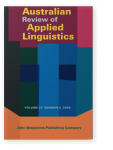Classroom discourse of an experienced teacher of Indigenous children
This paper1 will examine the discourse of one experienced teacher of Indigenous children in lessons observed as part of the Conductive Hearing Loss (CHL) project conducted by Edith Cowan University in Perth2. In the classroom observed, all the children were Indigenous and the teacher was aware that some children were suffering from CHL. This analysis will identify some features of the discourse of this teacher, who was very experienced in this context and who was identified as successful by her peers and the school community, with the aim of describing some of the strategies which contribute to her success. These strategies include constructing an inclusive classroom environment, empowering the students, avoiding authoritarianism and being responsive to the students. How these techniques are expressed in the discourse will be discussed here.
References (21)
Berry, M.
(
1981a)
Systemic linguistics and discourse analysis: a multi-layered approach to Exchange Structure. In
Coulthard, M. &
M. Montgomery (Eds)
Studies in discourse analysis (pp. 120–145). London: Routledge & Kegan Paul.

Berry, M.
(
1981b)
Polarity, ellipticity and propositional development, their relevance to the well-formedness of an exchange.
Nottingham Linguistic Circular, 10, 1, 36–63.

Berry, M.
(
1981c)
Towards layers of Exchange Structure for directive exchanges.
Network, 21, 23–32.

Cahill, R.
(
1999)
Solid English. Perth: Education Department of Western Australia.

CHL Project
(
2001)
Project summary. Perth: Kurongkurl Katitjin, School of Indigenous Studies, Edith Cowan University.

CHL Project
(
2003)
March newsletter. Perth: Kurongkurl Katitjin, School of Indigenous Studies, Edith Cowan University.

Christie, F. & Martin, J. R. M.
(Eds.) (
1997)
Genre and institutions: social processes in the workplace and school. London: Cassell.

Christie, M.
(
1985)
Aboriginal perspectives on experience and learning: the role of language in Aboriginal education. Geelong: Deakin University Press.

Coulthard, M. & Montgomery, M.
(
1981)
Studies in discourse analysis. London: Routledge & Kegan Paul.

Department of Education W.A.
(
2002)
Ways of being, ways of talk. Perth: Department of Education Western Australia.

Derewianka, B.
(
2003)
Making grammar relevant to students’ lives. In
Bull, G. &
M. Anstey (Eds.)
The literacy lexicon (pp. 37–65). Sydney: Prentice Hall.

Education Department of Western Australia, Catholic Education Office of Western Australia & the Association of Independent Schools of Western Australia
(
2000)
Deadly ways to learn [kit]. Perth: Deadly Ways to Learn Consortium.

Freebody, P., Ludwig, C. & Gunn, S.
(
1995)
Everyday literacy practices in and out of schools in low socio-economic urban communities. Nathan, QLD: Griffith University Education Faculty.

Gray, B., Cowey, W. & Rose, D.
(
1998, 1999, 2000)
Scaffolding reading and writing for Indigenous children in school. [Project reports]. Canberra: DETYA Indigenous Education Branch & University of Canberra.

Halliday, M.A.K.
(
1994)
An introduction to functional grammar. London: Edward Arnold.

Halliday, M.A.K. & Mathiessen, C.M.M.
(
1999)
Construing experience through meaning. London: Cassell.

Harris, S.
(
1982)
Aboriginal learning styles and the teaching of reading. In
J. Sherwood (Ed.),
Aboriginal education: issues and innovations (pp. 141–52). Perth: Creative Research.

Lock, G.
(
1996)
Functional English grammar Cambridge: Cambridge University Press.

Ludwig, C. & Herschell, P.
(
1996)
Talking – Our way into literacy. Melbourne: Curriculum Corporation.

Matthiessen, C. M. I. M.
(
1995)
Lexicogrammatical cartography: English systems. Tokyo: International Language Sciences.

Cited by (1)
Cited by 1 other publications
Thwaite, Anne
2007.
Inclusive and Empowering Discourse in an Early Childhood Literacy Classroom with Indigenous Students.
The Australian Journal of Indigenous Education 36:1
► pp. 21 ff.

This list is based on CrossRef data as of 29 june 2024. Please note that it may not be complete. Sources presented here have been supplied by the respective publishers.
Any errors therein should be reported to them.
